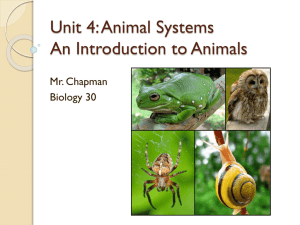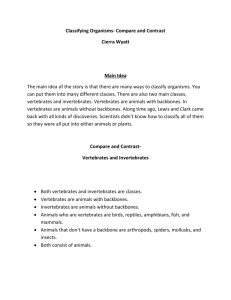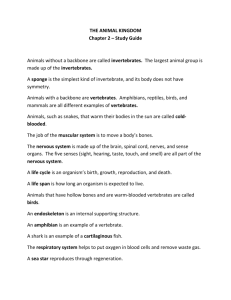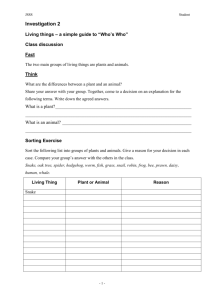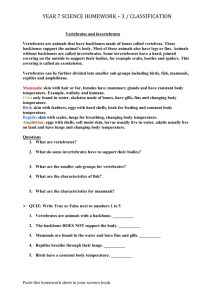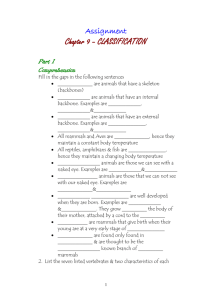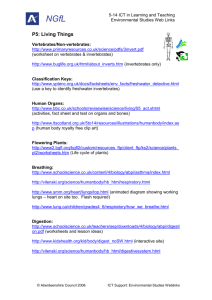11.2 Phylogenic Classification
advertisement
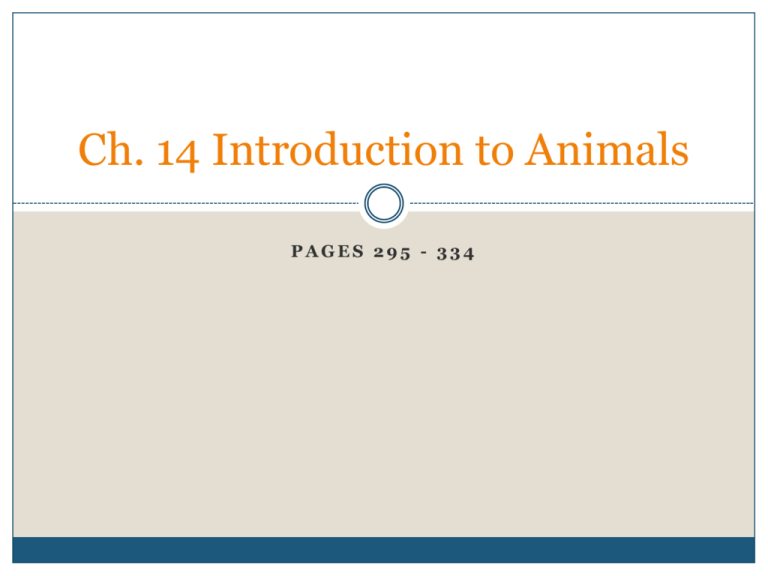
Ch. 14 Introduction to Animals PAGES 295 - 334 Introduction & Characteristics of Animals There is great variation within the animal Kingdom Despite the great differences there are several traits all animals share: All animals are multicellular (made up of 2 or more cells) All animals are eukaryotes (cells have a nucleus) Animals cannot make their own food, so they are heterotrophs Animals cells do not have a cell wall, they only have a cell membrane. This makes their cells more flexible and able to specialize. Animals: Importance and History Video (6:49) http://education-portal.com/academy/lesson/theevolution-of-animals-importance-evolutionaryhistory.html#lesson Animal Structure & Function Animals have specialized cells & most have tissues and organs which form organ systems (i.e. nervous system). Due to animals higher levels of organization they can perform complex functions such as: Detect environmental stimili All animals can move, at least during some stage of their life cycle. Virtually all animals have internal digestion of food. Animal Life Cycle & Reproduction Animals have a simple life cycle and spend the majority of their life as diploid organisms. Just about all animals reproduce sexually. The diploid adults will undergo meiosis to produce gametes (sperm & egg) cells Fertilization occurs when a sperm and an egg fuses, which turns into a zygote, which develops into an embryo, and finals turns into an adult. Overview of Meiosis Video: http://educationportal.com/academy/lesson/overview-ofmeiosis.html#lesson (6:35) Classification of Animals All animals share the same basic traits but they also show a lot of diversity. Animals range from simple sponges to complex humans. Animals are divided into more than 30 phyla. Animals are first divided depending on whether they are Invertebrates (animals that lack a vertebral column) or Vertebrates (animals that have a vertebral column) Invertebrates The majority of all animals are invertebrates Once again all invertebrates lack a backbone Invertebrates do not have bones but may have a skeleton, but it isn’t made of bone. There are 8 major phyla of Invertebrates Read and highlight the 8 major phyla of Invertebrates on page # 313 - 314 8 Major Invertebrates Phyla Porifera = sponges Cnidaria = jellyfish & corals Platyhelminthes = flatworms, tapeworms, & flukes Nematoda = roundworms Mollusca = snails, clams, squids Annelida = earthworms, leeches, marine worms Arthropoda = insects, spiders, crustaceans, centipedes Echinodermata = sea stars, sea urchins, sand dollars, sea cucumbers Vertebrates All vertebrates belong to the phyla Chordata Vertebrates are actually a subphylum of Chordata The main distinguishing feature of vertebrates is their vertebral column (backbone). The backbone runs from head to tail on the dorsal side of the body and is the core of the endoskeleton. Vertebrates also have a notochord, a dorsal hollow nerve cord, pharyngeal slits, and post-anal tail. Read & highlight the different classes of vertebrates on pg.# 318 – 321 Classes of Vertebrates There are about 50,000 vertebrate species, in nine different classes which are listed below Hagfish Lampreys Cartilaginous Fish Ray-Finned Fish Lobe-Finned Fish Amphibians Reptiles Birds Mammals Plants vs. Animals Read Pg. #323-328 Write down 3 differences between plants and animals. Major Organ Systems of the Human Body Read & highlight the major organ systems of the human body on pg.# 331-332 that you see below Cardiovascular System Lymphatic System Digestive System Endocrine System Integumentary System Muscular System Nervous System Reproductive System Respiratory System Skeletal System Urinary System Immune System Human Systems Videos Circulatory, Respiratory, Digestive, Excretory, & Musculoskeletal systems Videos: http://educationportal.com/academy/topic/physiology-i-thecirculatory-respiratory-digestive-excretory-andmusculoskeletal-systems.html Nervous, Immune, & Endocrine system Videos: http://educationportal.com/academy/topic/physiology-ii-thenervous-immune-and-endocrine-systems.html


